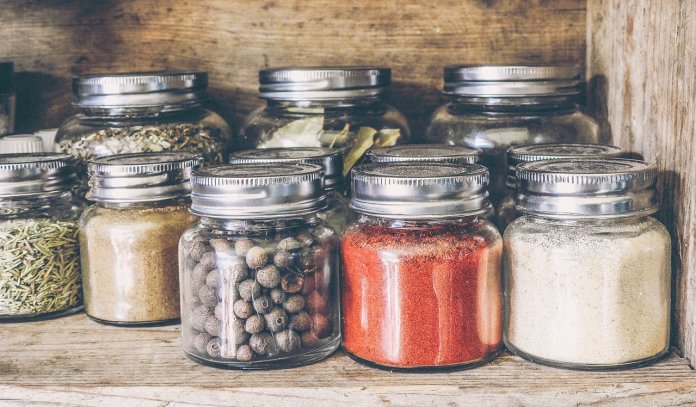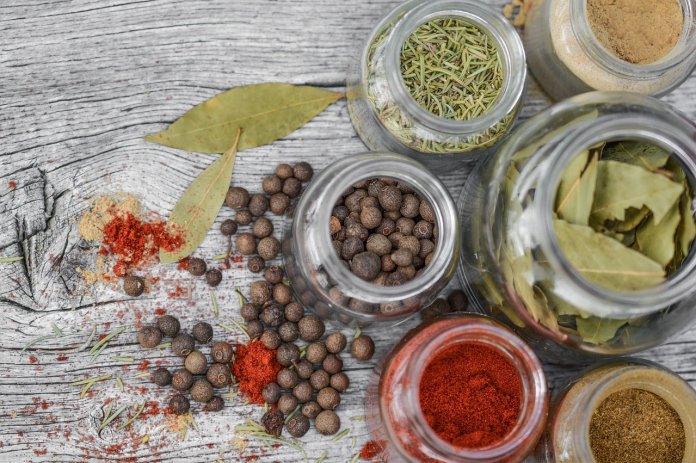Page Contents
List of Herbs and Spices you need to know
Following is the important List of Herbs and Spices you need to know in your daily life. These herbs and spices have had numerous benefits to human life for centuries. This List of herbs and Spices has been known by different names in different cultures.
However, the benefits are the same. In the modern era, various diseases are a great threat to human beings and create complications to human health. So, herbs and spices are playing an integral part to overcome these diseases. Here is the list of Herbs and Spices you should know in your routine life.

BASIL
Basil is the traditional accompaniment to tomatoes in Mediterranean cookery and an ingredient of the green Italian pasta sauce pesto piston in Provence. Basil is both tonic and calming to the nervous system a natural tranquilizer for the kind of frazzled nerves that lead to insomnia. If this is your problem, have a good ‘Soupe and pistou in the evening.
BAY
The distinctive flavor of bay leaves is an intrinsic part of the classic French hounguet garni — prized for their antiseptic properties and for their assistance to digestion, helping to ward off gas and cramps.
CARAWAY
In Central Europe, caraway seeds are a well-known aid to digestion: people chew a few of them before sitting down to a rich meal. They are particularly effective — like dill, which contains the same compound, carvone — for coping with wind or flatulence. Add them to potentially ‘‘windy dishes” such as cabbage or beans.
CHILI PEPPERS
Chili Peppers are used fresh, in the form of dried chili powder, or cayenne pepper. (Chilies are popular wherever people like their food with a real kick to the 20th-century herbalists had boundless faith in the lifesaving and restorative powers of chili or cayenne pepper: they used teaspoon doses at a time for typhoid and cholera patients in extremis.
Research has confirmed chill’s beneficent effect on the heart and 7 circulatory systems. And a short chili or cayenne added to a hot drink is a sure boost to sluggish digestion. Scientists have found that certain pungent foods, like mustard, | horseradish, chili, and garlic, contain constituents called mucokinetic agents that help shift excess mucus from the lungs so that it can be coughed up. So chilies and their derivatives are good for the respiratory system.
CHIVES
Chives share many of the healing properties of garlic and onions, which belong to the same family.
CINNAMON
Lends its delicate but distinct (flavor to dozens of minced meat or chicken dishes in Middle Pastern cookery, In Northern Europe one of The warming, winter’s favorites used in festive puddings of mulled wine. Cinnamon is a potent antiseptic. This is also tonic and stimulant: it warms the whole system and helps combat the fatigue and listlessness which so often attend a bout of flu or other virus infections, Add a stick to the hot, sweet toddy you take to bed at the start of a cold,
CLOVES
Cloves like cinnamon, are both powerfully antiseptic, and a warming boost to circulation: they are used in much the same way. Add a bruised clove or two to any herbal tea to provide an extra lift.
CORIANDER SEEDS
An essential ingredient of curry powders and for those cold appetizers cooked 4 /a grecque. Powdered, they add a distinctive North American flavor to meat and fish dishes. In hot stimulating food, this mild spice is valued for its cooling quality and its assistance in digestion.
CUMIN SEEDS
Another curry herb, but the incomparable smell given off by the warmed, crushed seeds evokes Middle Eastern cookery too. Use it in rich fried dishes or with beans to counter flatulence and dyspepsia.
DILL
This pretty feathery herb is a favorite accompaniment to fish in Scandinavia. Dried, it is a piquant addition to bland cheeses or to salad dressings. Babies taste dill in the form of gripe water, where it is highly effective: its name comes from a Saxon word meaning “to lull’,
FENNEL
The dark green fronds are a classic ingredient of the court-bouillon for fish dishes and soups: add them, too, to mayonnaise to serve with cold fish in summer, Fennel goes particularly well with rich fish like mackerel, An excellent aid to digestion, if prevents pas or colic.
GINGER
Another warming, antiseptic spice, widely used in the cookery of meat and fish in the Fast, where it helps counter putrefaction and is equally popular as a sweet spice in the West. Use the fresh root whenever possible: dried ginger is poor stuff by comparison. Ginger aids digestion and is unexpectedly useful against nausea: clinical trials have shown it to be more effective than the standard drugs against motion sickness. Fresh ginger grated into hot lemon and honey as a bedtime drink can stop a cold or chill in its tracks.
HORSERADISH
Most of us know this condiment only as it is made up of jars and eaten with roast beef. It deserves to be more adventurously used: try the fresh root grated into salad dressing, mayonnaise, or cottage cheese, or add a little too-natural yogurt as an accompaniment to smoked fish. Horseradish is an invigorating herb: powerfully stimulant to digestion — a reason for eating it with rich foods like roast beef; it also clears excess catarrh and counters infection.
JUNIPER
These tiny berries are what give it its unique flavor. They impart a powerful tang when used in cooking. Herbalists use them as a diuretic, and to help clear excess uric acid. Like so many culinary herbs they are also tonic to the digestive system.
MARJORAM
Sweet or pot marjoram is the gentler garden variety of wild marjoram or oregano and has similar qualities. Sweet marjoram is particularly valued for its calming qualities: the essential oil is strongly sedative.
MINT
There are many varieties of mint, a popular herb for flavoring light summer dishes. Mint sauce with lamb was for long regarded by the French as culinary barbarism, but now they too have acknowledged mint’s beneficial effect on the digestion, and have devised their own sauce paloise. Fragrant tea made with peppermint is a popular digestive throughout the Middle East and deservedly so. Mint also stimulates the heart and nerves. Drink this delicious tea instead of coffee for its mild lift. In-country medicine mint is believed aphrodisiac.
NUTMEG
This spice is familiar with so many favorite winter sweet treats. Nutmeg can have a mildly uplifting effect in small doses, and it is also good for digestion. Don’t overdo it, as it can be hallucinogenic in large quantities.
OREGANO
Oregano is the distinctive note in the smell of pizza. An obliging herb, it is almost as delicious dried as fresh. It is an effective antiseptic for the respiratory tract so enjoy plenty of it in winter. It’s also good for colic.
PARSLEY
Parsley is rich in vitamins A and C, iron, calcium, and potassium, as well as life-giving chlorophyll. It’s used in fresh and uses it lavishly. Herbalist’s value of parsley for its diuretic action: parsley tea was used in the trenches in World War I for soldiers suffering kidney complications following dysentery. It also helps eliminate uric acid, making it useful in rheumatism and gout.
Parsley tea was an old country aid to digestion: Maurice Messegué recalls the monster pot brewed by his grandmother Sophie, after a Lucullan feast of foe gras, roast chicken, sautéed mushrooms, crépes, custards, and apple tart. Add a bunch of fresh parsley whenever you make freshly pressed vegetable juice.
ROSEMARY
The inseparable companion of roast lamb and chicken in Mediterranean cookery, and once a more powerful friend to the digestive system, prompting the production of extra bile for fat digestion. Rosemary also stimulates the adrenal cortex: rosemary wine, in small doses, is valuable in states of general debility, including loss of memory, strain, and nervous tension.
SAGE
Sage and onion stuffing for the roast goose is true kitchen medicine: sage aids the digestion of rich, heavy food, and Italian cooks always add a leaf of sage to the pan when they fry sausages or pork. It also acts as a stimulant to the central nervous system and making it four valuable tonics for convalescents, or for those suffering from stress or nervous exhaustion. The French make a tonic wine with it — for the recipe is admirable for those run-down, or getting over a nasty viral infection. Sage is powerful stuff; however it can dry up mother’s milk — so don’t use it medicinally for more than a week at a time.
SAVORY, SUMMER
The German name of this peppery little plant means ‘bean-herb’ since it eases the digestion of this challenging food — try it with split peas, broad beans, and lentils too — and benefits the entire digestive tract. It has an antiseptic action on the gut.
TARRAGON
Tarragon has a delicate distinctive flavor this herb seems peculiarly French, used with roast chicken, sauces, in omelets, and to flavor a wine vinegar. The dried herb is a pale shadow of the fresh. Tarragon can help relieve gas, flatulence, and acidity.
THYME
Thyme contributes the deepest aromatic note in a bouquet garni. It would be hard to imagine a robust peasant daube of beef or a springtime lamb stew without this herb. Its medicinal qualities are just as impressive. Thyme is a powerful antiseptic, a general stimulant to the body’s natural resistance, with marked anti-viral and antibacterial activity and a tonic to the nervous system.
